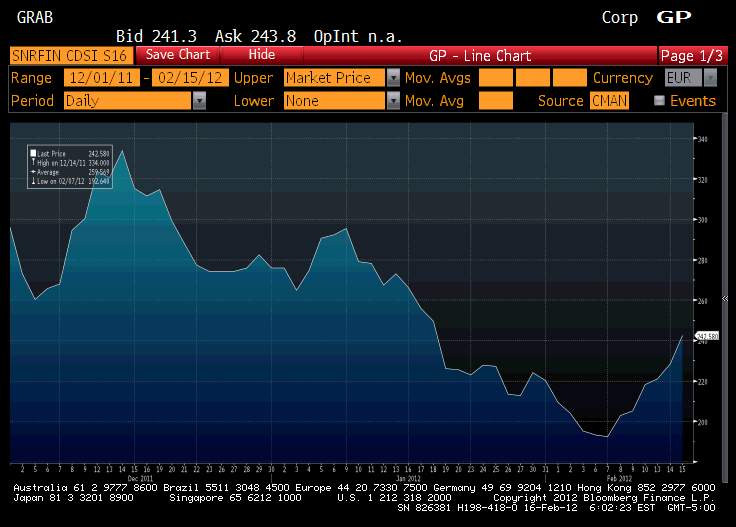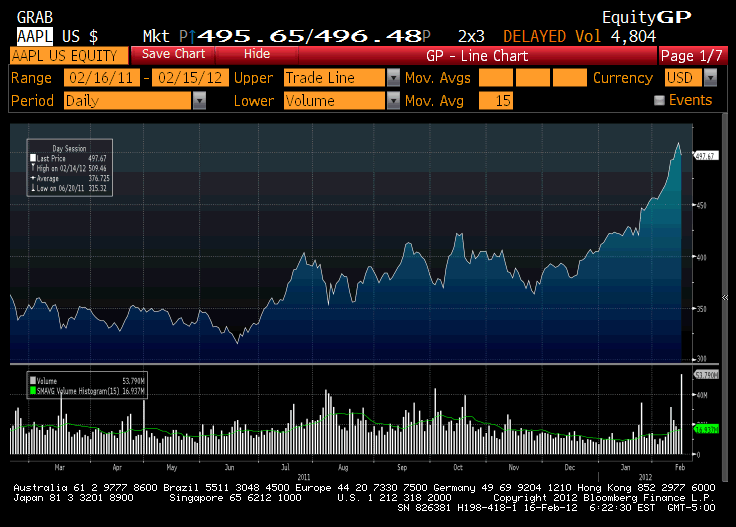A Pound Of Flesh. An AAPL A Day. Cheap HYG Vol.
Europe has moved into the “pound of flesh” stage of negotiations. Everyone just wants to make their point and the probability of a deal is dropping by the day. Europe is running out of time, and is just clueless. Yesterday has to confirm that even for the most optimistic person out there. They decided they should wait until the elections. Then they realized they had to deal with the March 20th bonds. Then they came up with a “bridge loan”. Clearly they didn’t bother to look up the definition of a bridge loan. A bridge loan is a loan that is meant to be temporary and has such punitive rates over time that the borrower is heavily encouraged to pay it back with new debt. This is just a “small” loan but one that is permanent and probably never getting paid back. I’m not sure if they asked the contributors whether they wanted to put up €16 billion which is somehow now “small”. Then noise came out that maybe Greece just shouldn’t have elections.
The Troika and Greece have been negotiating all this time and no effort was spent on figuring out a plan in the event of default. They are scrambling to come up with one. I remain convinced that Greece could do well in default if it is managed properly, but the chances of them doing anything properly is low.
The LTRO and its “infinite” capacity to lend to banks made everyone too complacent. Somehow the market took the backstop line as meaning bank credit risk was virtually non-existent. While we thought LTRO provided a lot of value to banks, it is not a cure-all, and banks highly levered (stuffed to the gills) with bad loans are not completely safe. We are seeing a turnaround in CDS spreads for European banks. They are off the wides of earlier this morning, when the index got to 254 bps but the trend is disturbing. This is the graph as yesterday. Today’s move isn’t included, but we are giving up most of this year’s gains and although still much better than pre-LTRO, it is worth watching. So many people were talking about how “riskless” financials had become post LTRO that this move has to be hurting a lot of people. They avoided financials in Europe for most of last year, only to pile in near the tights.
I’m not the first person to note Apple’s parabolic move, nor will I be the first to point out that parabolic moves tend to end badly, but it is worth repeating.
It has been on a tear and yesterday had some of the makings of capitulation as it screamed higher in the morning only to reverse and fade hard. Is that the end of the up move? Maybe not, but since it makes up about 3.7% of the S&P 500 it needs to be watched. Financials have been weak for about a week or so, but that move was masked in the indices by the performance of Apple. Another thing to worry about from the long side.
And finally, let’s look at the high yield market. HYG just had two days without any new share creation. That breaks a trend of almost relentless inflows. Is retail finally done throwing money at high yield? Without those new flows, the market could be at some risk, especially with the robust new issue calendar. HYG is trading at a discount to NAV. I don’t believe it is really at a discount, this is more of a function that NAV is still being marked closer to the offer side of the market in spite of the fact that the market has switched from being well bid, to well offered.
I am being told that many “credit hedge funds” are still sitting on 30% cash or something like that, so there is plenty of money on the sidelines. I continue to think that the concept of cash on the sidelines for a hedge fund is silly. They should be having longs and shorts. They should not just be beta funds (in spite of the fact that many are). So if a fund is supposed to have long and short ideas, the “cash on the sidelines” argument is foolish. Also, many funds use CDS, so they may in fact be levered but have cash on the sidelines. If you write 100 million of IG17 CDS, you only use a couple million of cash (as collateral), but that doesn’t mean you are “underinvested”. And finally, for the beta chasing funds, it means that they are 70% invested. So the long biased type funds have 70% of their money invested in a market yielding about 7%. So in the month of February, their carry would be about 0.625%. If the bonds drop 2%, they are down about 1% of NAV on the month. How many of these funds have that tolerance? Hedge funds always act as though they are levered because they cannot stomach negative months, and really, who out there “loves” high yield when it is providing low yields.
I really like buying puts on HYG. The implied vol is about half of that of the S&P, and I think a 4-5% move in the S&P will result in a 3-5% drop in HYG, so buy March puts on HYG to play an overall correction, and more importantly a correction in high yield. The flows are slowing, the market is rich, and liquidity is non-existent. The street has already done a self-imposed Volcker rule and is not taking much risk, and it is very safe to assume, that the average desk has used whatever risk limits they have to build up a little inventory because let’s face it, they like the carry, and figured they could sell the bonds to the ETF’s as they got more inflows.


